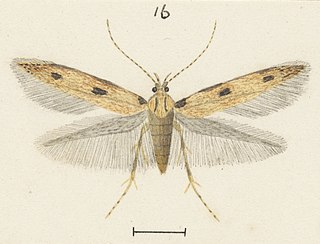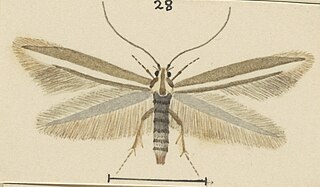
Copromorphidae, the "tropical fruitworm moths", is a family of insects in the lepidopteran order. These moths have broad, rounded forewings, and well-camouflaged scale patterns. Unlike Carposinidae the mouthparts include "labial palps" with the second rather than third segment the longest. With other unusual structural characteristics of the caterpillar and adult, it could represent the sister lineage of all other extant members of this superfamily. The genus Sisyroxena from Madagascar is also notable for its unusual venation and wing scale sockets.

Epermeniidae or the fringe-tufted moths is a family of insects in the lepidopteran order with about 14 genera. Previously they have been divided in two subfamilies Epermeniinae and Ochromolopinae but this is no longer maintained since the last group is probably hierarchically nested within the first. They are presently placed in their own superfamily but have previously been placed among the Yponomeutoidea or Copromorphoidea with which they share some features. Their systematic placement among the apoditrysian group "Obtectomera" is however uncertain. They show some morphological similarities to the "plume moths", for example the wing fringe has similar groups of scales. There are also some similarities to Schreckensteinioidea, for example spiny legs and at least in some species an open-network cocoon. The genus Thambotricha from New Zealand may be the sister group of all other extant members. The most important genera are Epermenia, Ochromolopis and Gnathifera. The group has been extensively revised and catalogued by Dr Reinhard Gaedike.

The Archipini are a tribe of tortrix moths. Since many genera of these are not yet assigned to tribes, the genus list presented here is provisional.

Dichomeris is a genus of moths in the family Gelechiidae erected by Jacob Hübner in 1818.

Asaphodes is a genus of moths in the family Geometridae erected by Edward Meyrick in 1885. This genus is endemic to New Zealand and species within this genus are found throughout New Zealand including the North, South and Stewart / Rakiura Islands.

Dichromodes is a genus of moths in the family Geometridae first described by Achille Guenée in 1857. The type species is Dichromodes ainaria.

Lecithocera is a genus of moths in the lecithocerid subfamily Lecithocerinae. The genus was erected by Gottlieb August Wilhelm Herrich-Schäffer in 1853.

Opogona is a genus of the fungus moth family, Tineidae. Therein, it belongs to the subfamily Hieroxestinae. As it includes Opogona omoscopa, the type species of the now-abolished genus Hieroxestis, it is the type genus of its subfamily.

The Oecophorinae are the nominate subfamily of moths in the concealer moth family (Oecophoridae). They are part of the insufficiently studied superfamily Gelechioidea, and like their relatives, the circumscription of this taxon is disputed.

Autosticha is a genus of gelechioid moths. It belongs to the subfamily Autostichinae, which is either placed in the concealer moth family (Oecophoridae), or in an expanded Autostichidae. It is the type genus of its subfamily. Originally, this genus was named Automola, but this name properly refers to a fly genus in family Richardiidae.

Labdia anarithma is a moth of the family Cosmopterigidae. It was described by Edward Meyrick in 1888. It is found in New Zealand and throughout Australia. Adults are on the wing from December to March and are day flying. They have been collected by sweeping bracken fern.

Prepalla austrina is a moth of the family Oecophoridae. It was described by Edward Meyrick in 1914 under the name Saropla austrina. Meyrick later moved the species into the genus Oxythecta. However in 1997 its taxonomy was reconsidered by Ian Francis Bell Common and the species was included in the genus Prepalla. It is endemic to New Zealand and is present in Otago. The host plant for this moth is Leucopogon fraseri.

Calicotis is a genus of moths in the family Stathmopodidae, although it is sometimes included in the family Oecophoridae. In 2024, the genus Pachyrhabda was synonymised with Calicotis.

Pachyrhabda is a former genus of moths in the family Stathmopodidae. In 2024, this genus was synonymised with Calicotis.

Elachista plagiaula is a moth in the family Elachistidae. It was described by Edward Meyrick in 1938. E. plagiaula is endemic to New Zealand and has been observed in the Mackenzie Basin in the South Island. The preferred habitat of this species is alpine snow-grass. Adults are on the wing in December and are active at dusk.

Athrips zophochalca is a moth of the family Gelechiidae. It was described by Edward Meyrick in 1918 and is endemic to New Zealand. A. zophochalca has been observed in both the North and South Islands as well as at the Poor Knights. The species inhabits scrubby native forest, saline wetlands and braided river habitat. Larvae bore into the terminal shoots of Carmichaelia species. Adults are on the wing from November until March and are sexually dimorphic with the male lacking the white band on the forewings.

Lepidoscia is a genus of bagworm moths in the family Psychidae. There are more than 40 described species in Lepidoscia, found primarily in Australia and New Zealand.
Calicotis antinoma is a moth of the family Oecophoridae first described by Edward Meyrick in 1910. It is found in New Zealand at the Kermadec Islands and has also been collected in Australia.

Orthenches prasinodes is a moth of the family Plutellidae. It was first described by Edward Meyrick in 1885. This species is endemic to New Zealand and has been observed in both the North and South Islands in the Wellington, Canterbury and Southland regions. It inhabits native forest. The larval host are species in the genus Muehlenbeckia and larvae have been raised on Muehlenbeckia complexia. Adults are on the wing from December until March.

Trachypepla is a genus of moths of the family Oecophoridae. It was circumscribed in 1883 by Edward Meyrick. The species within this genus are indigenous to Australia and New Zealand.



















